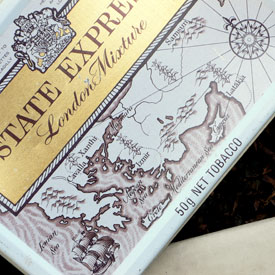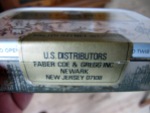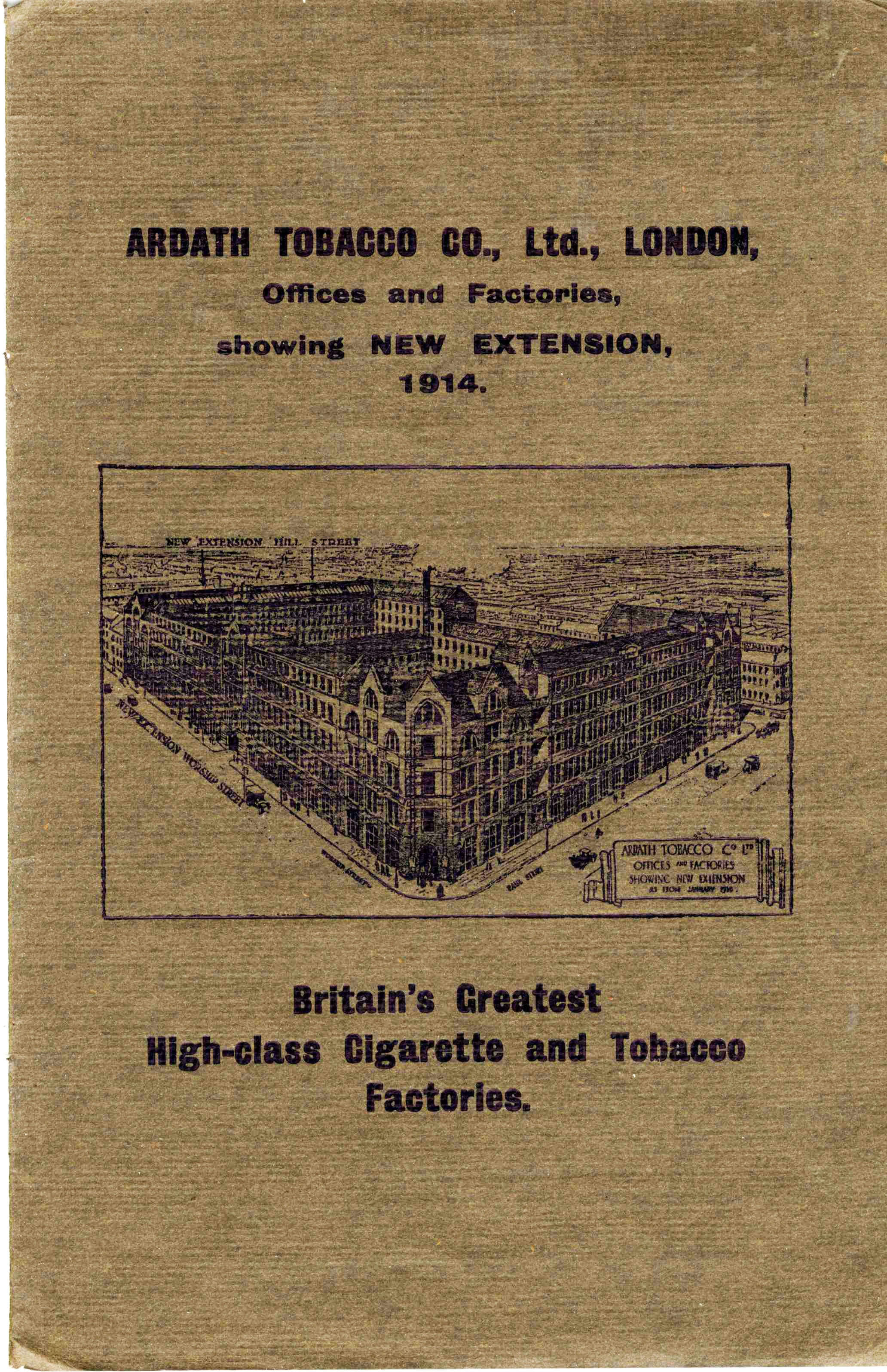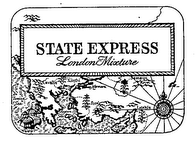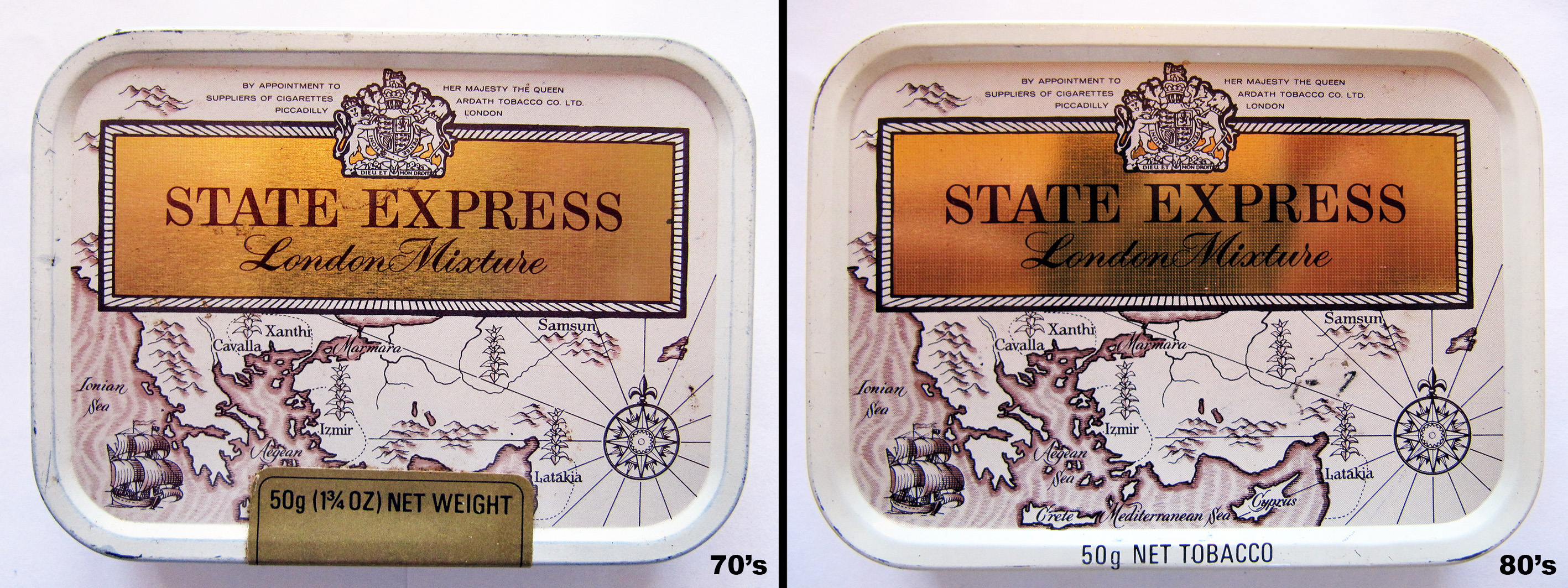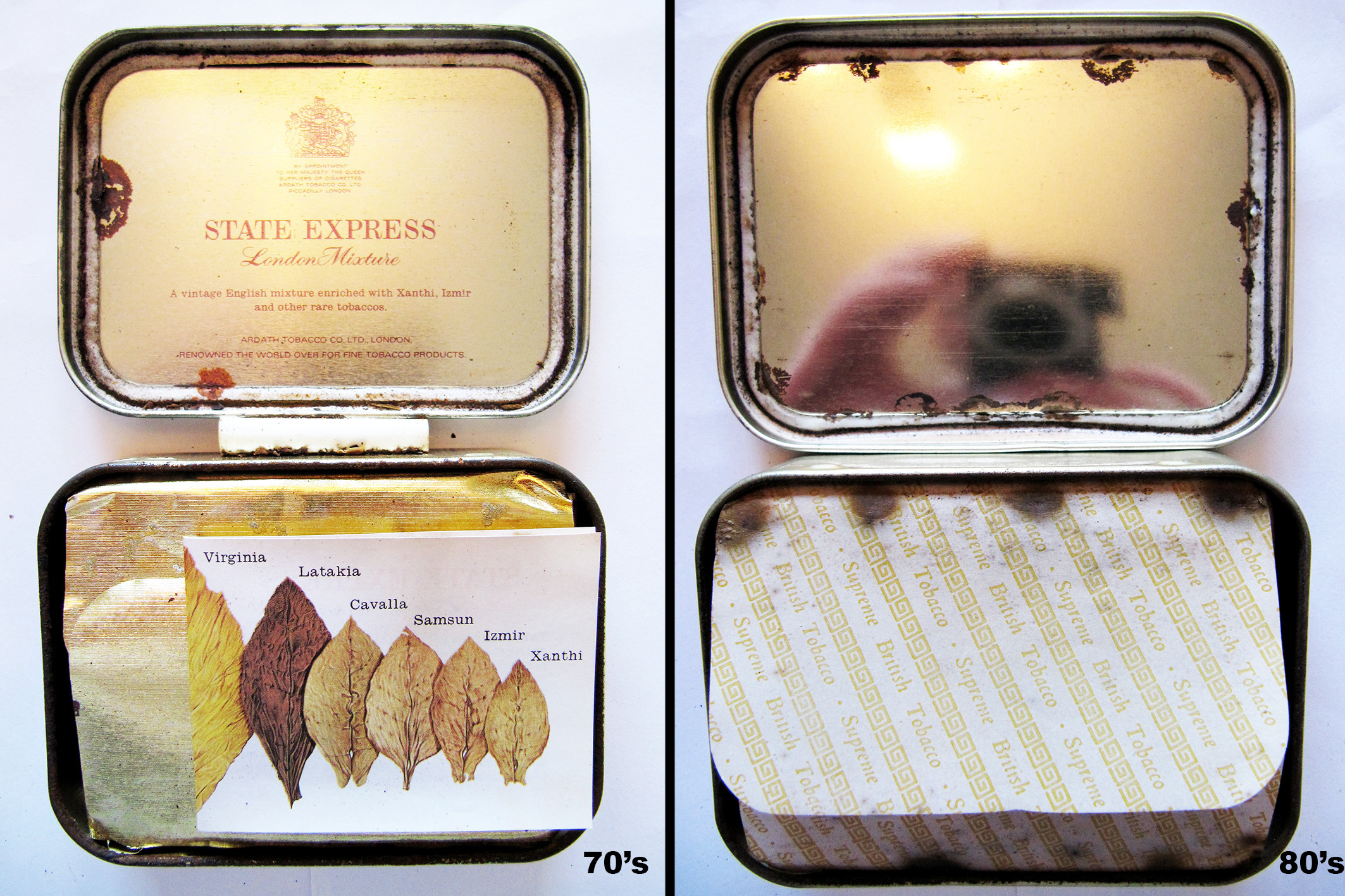 One of the great old names in the pipe-tobacco pantheon is that of John Cotton. Mostly known for their No. 1 (Mild), Nos. 1 & 2 (Medium) and Smyrna blends. My first encounter with the brand was some time ago at the end of the first year I started smoking pipe. I had done some research about the old venerable pipe-tobacco names and while surfing ebay stumbled upon an old sealed tin of John Cotton No. 1 Mild. I can’t remember what I paid but the price was very reasonable. However when I smoked the mixture I was not impressed. I had just started smoking latakia blends such as Old Dublin, Nightcap and Balkan Supreme and found No. 1 Mild too.. Mild.. How wrong I was in hindsight..
One of the great old names in the pipe-tobacco pantheon is that of John Cotton. Mostly known for their No. 1 (Mild), Nos. 1 & 2 (Medium) and Smyrna blends. My first encounter with the brand was some time ago at the end of the first year I started smoking pipe. I had done some research about the old venerable pipe-tobacco names and while surfing ebay stumbled upon an old sealed tin of John Cotton No. 1 Mild. I can’t remember what I paid but the price was very reasonable. However when I smoked the mixture I was not impressed. I had just started smoking latakia blends such as Old Dublin, Nightcap and Balkan Supreme and found No. 1 Mild too.. Mild.. How wrong I was in hindsight..
In 2015 The Standard Tobacco Company of Pennsylvania brought back several old tobacco-brands from the abyss of oblivion under which the celebrated Bengal Slices and some of the John Cotton range. “Ah, they also have re-made Smyrna, I forgotten about that one!” I thought. I always loved oriental forwarded blends so I ordered some tins. And the tobacco did not disappoint me, I loved it! Master-blender Russ Ouellette did a wonderful job re-creating the old mixture. Some months ago I was surfing ebay again and to my surprise I saw a vintage John Cotton’s Smyrna tin up for auction, they are pretty rare. Probably some rich American, Russian or Chinese guy was going to pay big bucks for it so I set my bid not too high, more like a kind of joke than a serious offer. When I awoke the next morning I saw to my amazement that I had won!
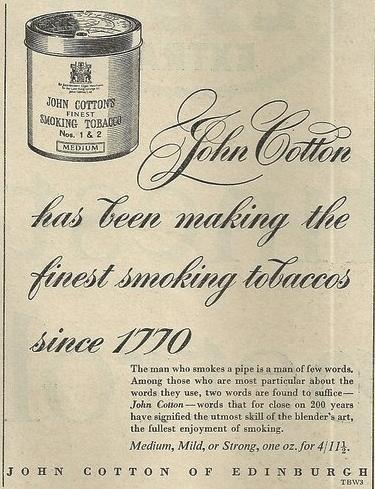 Sorting out the history of John Cotton was rather difficult and time consuming. At first I could only find a little bit of information on the internet like the Firesign Theatre & Gresham’s Law document by the great Jon Guss, which mentions John Cotton. Good friend Troy Lloyd had a few pictures but nothing more and there was some loose information on several pipe-fora. But they did steer me into the right direction; the wonderful Scottish Post Office Directories for Edinburgh. There (and in later phone-books) I discovered the history of John Cotton. In contrast with common belief the firm was not founded in 1770. I know, on (old) advertisements and tins it says so, but it is not true. Also Jon Guss says that the first Cotton established his tobacco shop in Edinburgh in 1773. I could not find evidence for that so Jon, if you read this, let me know why you think it is 1773!
Sorting out the history of John Cotton was rather difficult and time consuming. At first I could only find a little bit of information on the internet like the Firesign Theatre & Gresham’s Law document by the great Jon Guss, which mentions John Cotton. Good friend Troy Lloyd had a few pictures but nothing more and there was some loose information on several pipe-fora. But they did steer me into the right direction; the wonderful Scottish Post Office Directories for Edinburgh. There (and in later phone-books) I discovered the history of John Cotton. In contrast with common belief the firm was not founded in 1770. I know, on (old) advertisements and tins it says so, but it is not true. Also Jon Guss says that the first Cotton established his tobacco shop in Edinburgh in 1773. I could not find evidence for that so Jon, if you read this, let me know why you think it is 1773!
-
1774: The first year I can find anything of a Cotton. Not a John Cotton but George Cottons, the founding father so to say. The following years he moves from location to location throughout the city.
- 1813: For the first time several tobacconists with the Cotton name can be found: George junior and James.
- 1820: Tobacconist James Cotton has disappeared from the directories.
- 1822: James is back together with a new Cotton tobacconist: William.
- 1826: A very important year because for the first time a John Cotton is mentioned as tobacconist.
- 1829: One of the George’s and John Cotton are not mentioned in the directory.
- 1834: A good year for the Cottons, John is back and the remaining George has become tobacconist to king William IV.
- 1838: James is replaced by Chas W. and because of a royal death George is now tobacconist to the late king.
- 1839: William Cotton is no longer mentioned but a George S.S.C. is.
- 1840: Chas is gone, James is back and George is once again a royal tobacconist. Only now to a woman, her majesty Victoria.
- 1846: Perhaps the Queen herself is not a big fan of George (& Son) Cotton because now he holds the title of “Tobacconists to the Royal Household”. The following years nothing much changes.
- 1872: For the first time a Cotton (George & Son) is listed on the now famous 100 Princes Street address. John Cotton is nearby on 122 Princes Street.
- 1879: A mention is made in the Edinburg Gazette of the dissolution of co-partnership between John Cotton and George Cotton, apparently they were partners.
- 1884: It seems that George Cotton & Son and John Cotton are the only Cotton tobacconists left. The latter is now active on the well known 7 Frederick Street address.
- 1890: George Cotton & Son loses the “Tobacconists to the Royal Household” title.
- 1905: Apparently business is going well for John Cotton, for the first time a factory is mentioned on 10 Abbeymount.
- 1906: An important year, Limited is now added after the John Cotton name and a new factory is put into service on 172 Easter Road. In fact, this building still exists! Today it is a business centre and the original chimney with the letters “JC” on it has survived.
- 1907: John Cotton Limited gets an office at 11 Duke Street with a secretary: J. Aikman Smith.
- 1933: Not 1 but 2 secretaries, J. Aikman Smith and Wells at the new office address of 8 Forres Street.
-
1935: The first year that John Cotton Limited is active on the 100 Princes Street address although George Cotton & Son also remains there.
- 1954: Suddenly there is a George Cotton Limited and the 100 Princes Street address is no longer mentioned. Only the 172 Easter Road factory is named.
- 1955: George Cotton Limited is no longer mentioned, only John Cotton Limited remains on the factory address.
- 1962: John Cotton Limited is acquired by Gallaher.
- 1963: John Cotton Limited is no longer mentioned in Edinburgh. The address now is in the Trafalgar House, Waterloo Place in London.
- 1968 and beyond: I can’t find John Cotton Limited any more in the phone-book. Some later addresses I found on the internet and the No. 1 Mild tin are 65 Kingsway, London W.C.2 and P.O. Box 14, Rowdell Road, Northolt, Middlesex.
- 1972: A memorandum is written about John Cotton smoking tobaccos manufactured in Denmark (by Erik Stokkebye): Harvest Gold, Burley, Rich Mellow Virginia, Honeydew, Gaelic Mixture and Danish Aromatic.
- 1986: In a Gallaher document John Cotton’s No. 1 Mild and Nos. 1 & 2 Medium are mentioned. After this date I can find nothing, the brand disappeared.
Now a comparison between the vintage and re-made John Cotton Smyrna. I had some help in the person of Robbin, an experienced vintage blend smoker with a good tasting palette.
 Package/tin:
Package/tin:
Vintage John Cotton Smyrna: There were several kinds of tins in which Smyrna came. I have seen pictures of knife-cutter tins, rectangular ones and the version I have is a round 50 gr. one. The background colour is white with on it the well-known lion holding tobacco leaves in red. The letters “John Cotton’s Smoking Tobacco” are in black and “Smyrna” in between them is in red. On top of the tin it says “Made in the United Kingdom”, on the bottom is a banner with in it “A blend of Smyrna and other fine tobaccos”. For me the whole has a kind of weird Wild West appearance because of the used fonts. Hell, “Smyrna” even has bullet holes in it! I don’t know what the original graphic designers smoked when they designed the tin, but certainly not Smyrna!
Re-made John Cotton Smyrna: Also a round tin and ladies and gentlemen graphic designers, this is a prime example of excellent tin-artwork. I like it way better than the old design to be honest. The background is beige with on it the lion in gold. In the middle is a classic looking dark-green banner with in the text “John Cotton’s (in serif font) traditional English pipe tobacco mixture (in a sans-serif font).” The edges of the banner are in gold and together with the lion are made with embossed printing. Below the banner is the name of the blend, Smyrna, also in a serif font. The golden embossed printing combined with the fonts make this tin look real classy.
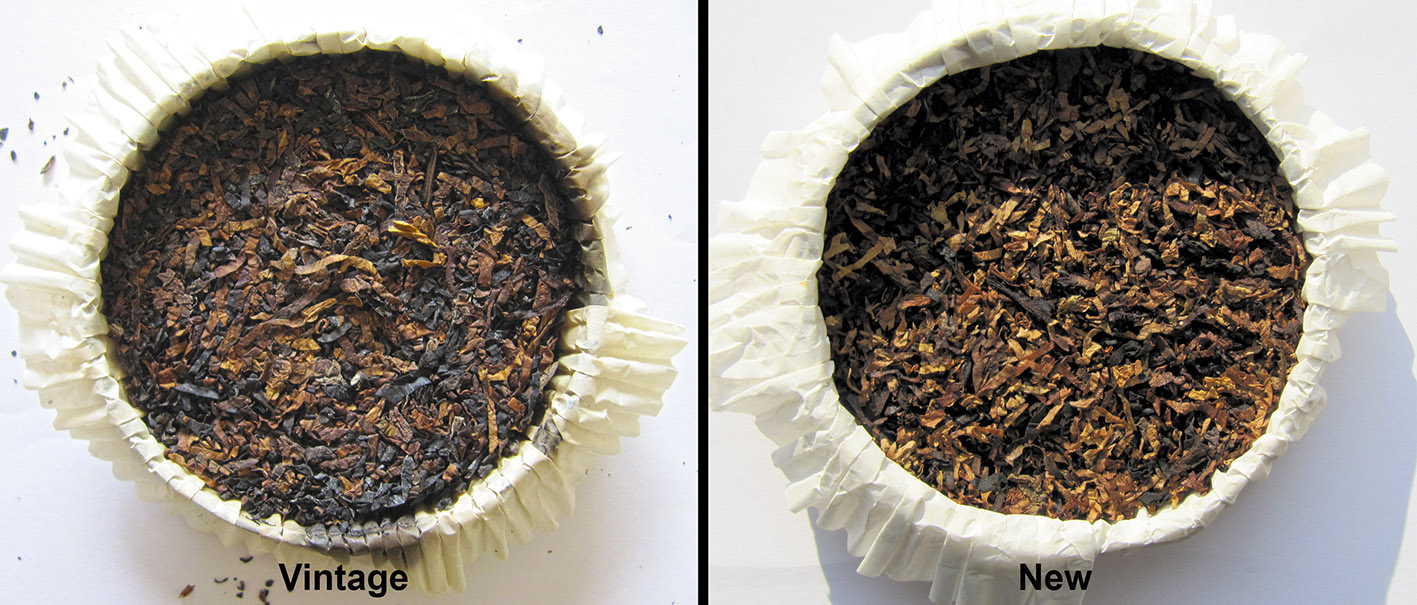 Contents/Ingredients/cut:
Contents/Ingredients/cut:
Vintage John Cotton Smyrna: Upon opening the tin I am greeted by a simple white carton with nothing on it. Hmm, at least the inlay in my old No. 1 Mild tin had some printing on it. When I remove it I see a colourful ensemble of latakia, Virginia and Turkish strands with quite a lot of the dark leaf in it. The cut is a good ol’ fashioned ribbon cut.
Re-made John Cotton Smyrna: When I open the tin I see a transparent plastic inlay upon the tobacco. Oh well, better than nothing. Compared to the vintage Smyrna the tobacco colours in this version are similar but brighter. Also there are more lighter strands in my opinion. The cut is a thin ribbon cut.
 Smell from the tin:
Smell from the tin:
Vintage John Cotton Smyrna: This blend surprised me, after all these years I thought the latakia had toned down a bit but no, when I first smelled it, whoaahh.. Definitely not Syrian latakia but strong assertive Cyprian. For the rest I detect a little woodsy sweet and sour odour.
Re-made John Cotton Smyrna: Yup, there is latakia in this one, no question about it. But besides that the (fresher) smell isn’t that different from its older brother. Despite the presence of more lighter tobacco-strands. However I do detect a tiny little bit of topping, coumarin (a chemical also to be found in for example cinnamon, tonka-bean and deer-tongue), which I can’t smell on the vintage version*.
 Taste:
Taste:
Vintage John Cotton Smyrna: Ahh.. This is how I want all my tobaccos to taste like at the first light. Almost no bitterness, the Turkish and latakia are fighting about the main role and it is full, round and smooth as Ellen her bottom. A bit further the grassy, earthy Virginia comes into play a bit more. Towards the middle the superb Turkish are winning the fight and the whole becomes a big rich flavour-bomb; cedar, spice, sweet, sour, chocolate creamy, leather you name it, the blend all has it. Robbin remarks that this part also reminds him a bit of red wine. Towards the end of the bowl the different components really become one and burn down to a fine grey ash.
Re-made John Cotton Smyrna: I can remember the first time I smoked the re-made version, I instantly fell in love with the taste. Cyprian woodsy and leathery latakia that is kept under control by the grassy Virginia and spicy and sour Turkish, yummie! Now I have smoked the vintage version I am a bit amazed that the latakia there seems more powerful as the re-made one. Despite the unquestionable presence of the fresh dark leaf the newer leans more on the Turkish and Virginias in my opinion. Or at least, they are more detectable, the taste is more clear. Perhaps everything has melted so together in the old one that I get this result. I can also taste a tiny little bit of the coumarin topping which for me is pleasant*. Towards the middle the Turkish come even more forward and it more or less stays this way until the end.
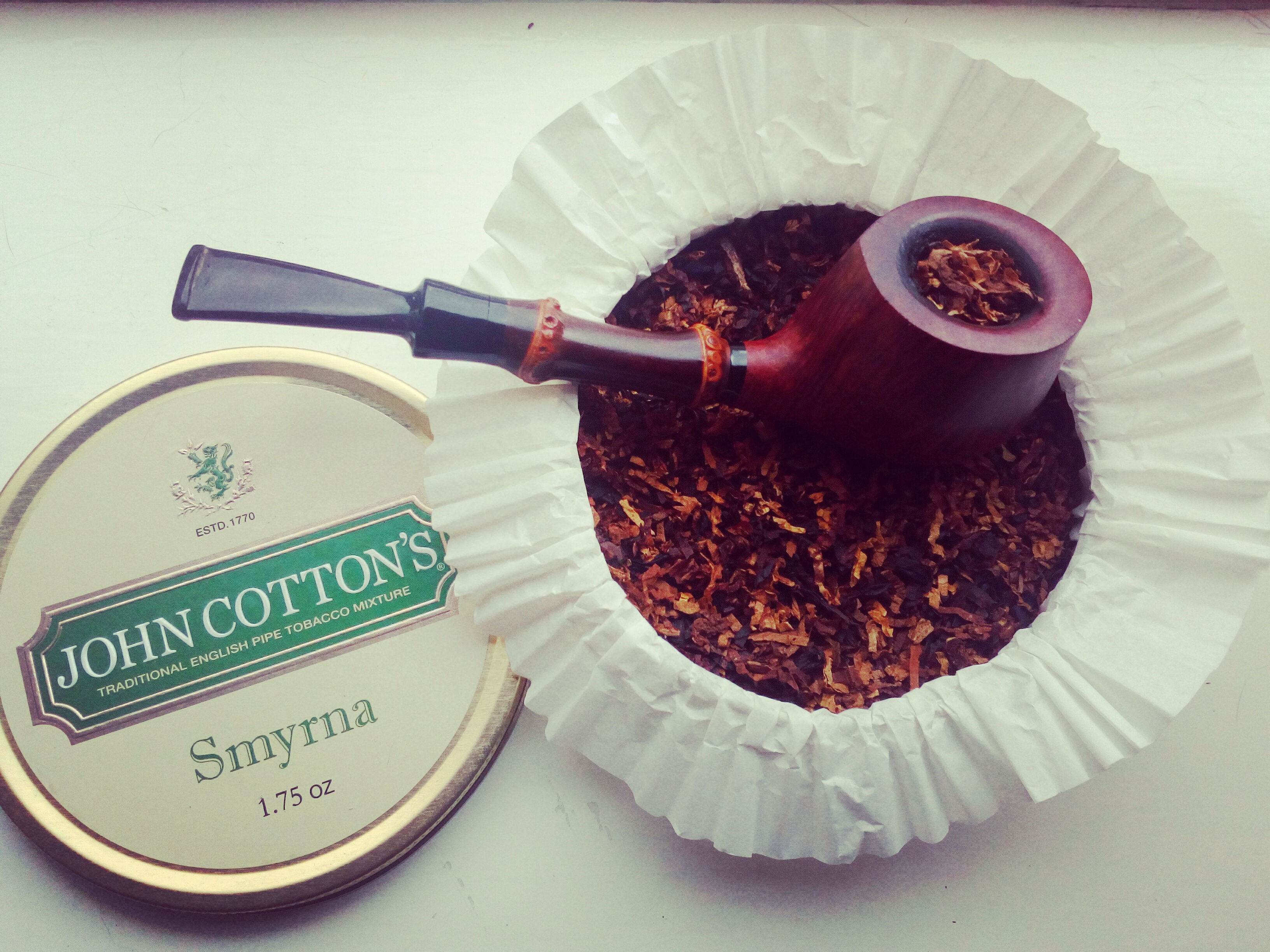 Miscellaneous:
Miscellaneous:
Vintage John Cotton Smyrna: The tobacco had the perfect moisture when I opened the tin and the ol’ fashioned ribbon cut made filling the bowl and smoking the pipe easy. The nicotine level is just above medium and there was absolutely no tongue bite.
Re-made John Cotton Smyrna: I had to get used a bit to the springy, thinner ribbon cut but after a couple of times you know how to best fill your bowl. Simply don’t press the tobacco too hard. The blend does not bite but if you puff too hard an fast it can burn hot. Vitamin N level is medium.
 Room-note:
Room-note:
Vintage John Cotton Smyrna: For a latakia blend the room-note is pretty decent! I could smoke it without a complaint from Ellen. The next morning a lovely incense smell lingered.
Re-made John Cotton Smyrna: This one has one of the best room-notes I have ever smelled for a latakia mixture. Like the old one incense-like and perhaps enhanced by the coumarin*.
 Price:
Price:
Vintage John Cotton Smyrna: I paid €61 for it, not too bad!
Re-made John Cotton Smyrna: At 4noggins you pay $11.99 (± €10,03) for a 1.75 oz. tin.
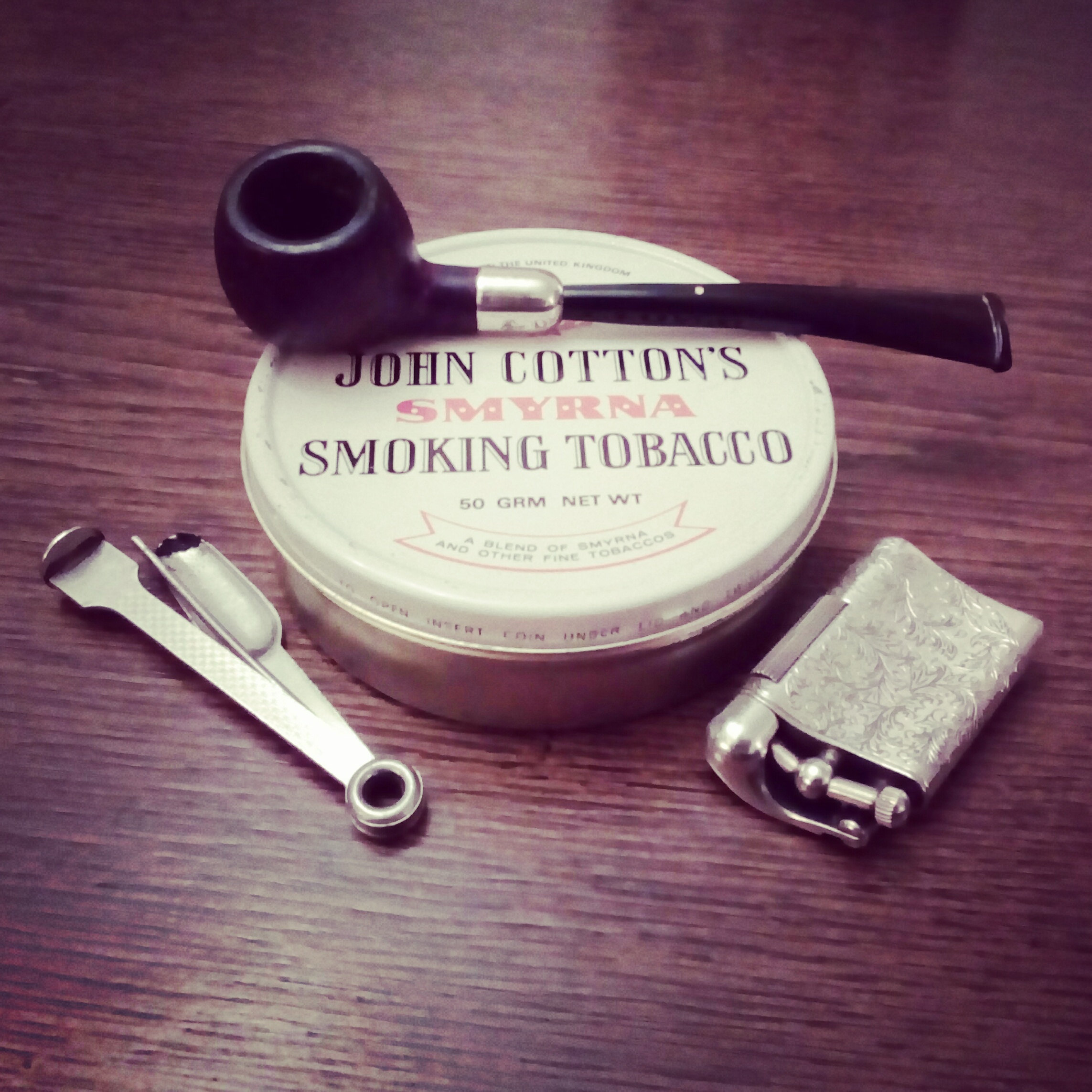 Conclusion:
Conclusion:
Vintage John Cotton Smyrna: It is an excellent blend, I can understand why people still speak with respect about the old John Cotton Smyrna. It totally talks the talk and walks the walk so to say. I had many very pleasant evenings smoking it. It is a blend that demands attention, grabs you by the balls and does not let loose. For Robbin and me one of the remarkable things was that the latakia had not really subdued, it was still powerful. We both rate this mixture a 8.5 out of 10.
Re-made John Cotton Smyrna: First of all Russ Ouellette did a wonderful job re-creating the old blend. It is not exactly a copy but according to Robbin more an excellently executed remake. When I smoke it and I keep in mind the ageing process, well, in 30 years it could be where the vintage version is now. And that is a compliment! Robbin and I both rate this mixture a 8 out of 10. Oh, and that vintage No. 1 Mild I thought was too mild, I love it now. But I have to end this blogpost in a sad way. Probably the new version will not be amongst us much longer. See this Facebook message from one of the founders of the The Standard Tobacco Company of Pennsylvania, Dan Z. Johnson:
Buy It While You Can
With the FDA Deeming Regulations poised to take effect in about two weeks, I have some sobering news for our friends. Unless something changes, there will not be another production run on the 5 original Standard Tobacco Co. of PA blends. Once the current inventory of War Horse, Bengal Slices and John Cotton’s is sold, there will be no more. Ever.
I’ve held off making this announcement until I was certain that the end is near. August 8, 2018 is the cut-off date for selling post 2007 blends such as ours without an FDA Substantial Equivalence (SE) approval. Since it now appears highly unlikely that we will get an SE, and since our distributor does not want to get stuck with product that they can not sell, their plan is to sell out existing stock and not re-order.
Caveat: If we sell out of everything quickly, the distributor might change their mind and do another run, but that is doubtful given the glut of new, last ditch blends clogging up production and warehouse space. Also, if the FDA is forced by congress to change the grandfather date to include post 2007 blends such as ours, then we are free to continue production. That, however, is exceedingly unlikely at this point in time.
I can’t tell you how sad and disappointed I am to have to tell you this. It’s not where we wanted to be at this point in time, but I wanted to give you all the opportunity to order your favorites before it’s too late.
* EDIT 25-9-2017: In the comment below this post Russ Ouellette says that there is no top dressing on the re-made Smyrna. So I don’t know what I smelled and tasted, but certainly no coumarin!
 EDIT 16-1-2018: I received a mail and picture from Andrew Robertson. Apparently his mother worked at the Cotton’s factory in Easter Road, Edinburgh from 1935 until she joined the army as a Radar Operator in 1941. The picture was taken outside the Cotton Factory at Sunnyside on Easter Road Leith circa 1939. Andrew’s Mother, Alice Bowie as she was then, is 2nd on the left of the back row, immediately behind the foreman. His mother’s friend May Wilkie is standing on the right of the picture. Andrew’s mother always explained that she and May made “cocktail” cigarettes similar to the Sobranie brand.
EDIT 16-1-2018: I received a mail and picture from Andrew Robertson. Apparently his mother worked at the Cotton’s factory in Easter Road, Edinburgh from 1935 until she joined the army as a Radar Operator in 1941. The picture was taken outside the Cotton Factory at Sunnyside on Easter Road Leith circa 1939. Andrew’s Mother, Alice Bowie as she was then, is 2nd on the left of the back row, immediately behind the foreman. His mother’s friend May Wilkie is standing on the right of the picture. Andrew’s mother always explained that she and May made “cocktail” cigarettes similar to the Sobranie brand.




